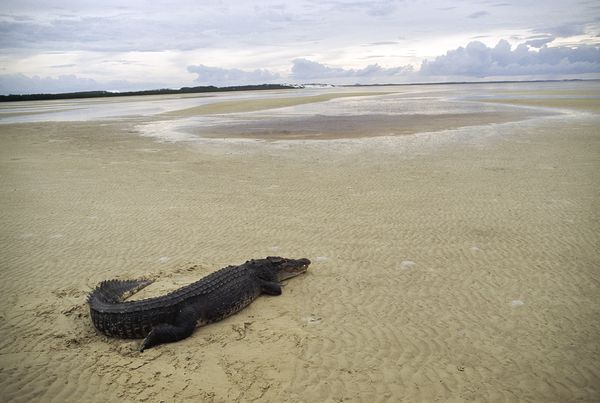
Saltwater crocodiles in the South Pacific travel between islands by body surfing, according to new research designed in part by late "Crocodile Hunter" Steve Irwin.
The world's largest living reptile, the saltwater crocodile is found in brackish and freshwater habitats extending east-west from East India to Fiji and north-south from southern China to northern Australia.
Despite being found on several islands across this range, different crocodile groups haven't evolved into completely unique species - the way Darwin's finches evolved on the Galápagos Islands.
That suggests the crocodiles are somehow island hopping, keeping the overall gene pool well mixed. But until now, no one was sure just how the crocs were traveling, as they're excellent swimmers for short distances but aren't great at long, endurance swims.
Crocodile Surfers Wait for Righteous Waves
With Irwin's help and partial funding, a team led by biologist Hamish Campbell of Australia's University of Queensland began developing an experiment in 2006 to try and solve the mystery.
The team tagged 27 crocodiles with acoustic transmitters, each "the size of a pinky finger," said team member Craig Franklin, a University of Queensland zoologist. The crocs were also fitted with sensors for recording water temperatures and depth.
The crocs' home river in Queensland was then outfitted with "listening posts," allowing the researchers to track the tagged animals.
After collecting data for a year, the team found that, before journeys of six miles (ten kilometers) or more, the reptiles would make use of outgoing tides, riding the surface currents that sweep water toward the mouths of rivers.
If the currents changed, the crocs would climb onto river banks or sit on riverbeds, waiting until surfing conditions improved.
The researchers then reanalyzed existing data on crocodiles in the open ocean. Those crocs were doing the same thing, the data show - using currents to body surf for 60 miles (100 kilometers) or more.
One surfing crocodile even spent 25 days on a 366-mile (590-kilometer) journey down the coast of the Cape York Peninsula, in the upper east part of Australia.
Surfing Hints at Crocodiles' Navigation Skills
But the team is still puzzled as to why saltwater crocodiles will surf such great distances: "It appears not to be migratory," Franklin said. "We haven't seen repeat patterns."
It's possible the crocs are traveling in search of mates or food - the reptiles seem to especially frequent small islands, where they can snap up the sea turtles that have clambered onshore to lay their eggs, Franklin said.
No matter the reason for their journeys, the study shows that the scaly beasts must have impressive navigational instincts, he said.
"If you think about most animals that travel long distances, they'll swim in one direction," Franklin said.
"With a crocodile, they have to navigate all these features" - surfing from rivers to deltas and across the open ocean to various islands - "to get from A to B. It's not in a straight line, so they must have a very sophisticated navigational ability."
That is, of course, assuming that the crocodiles have a specific destination in mind when they set off, which Franklin doesn't know is true. But judging from the animals' behavior, it's likely, he said.
"If the croc is swimming only a short distance, it will swim against the current as well. Everything over ten kilometers [six miles], they purposely wait for the currents to be favorable. It's almost like they are predetermining that they're going to do a long swim before they take off."
Irwin, who died just a few months after the study team began development, probably would have loved to know the results of the new research, Franklin added. Irwin "had a large number of questions and honestly wanted to know more about the crocodile. For him it was about making new discoveries."



Reader Comments
to our Newsletter